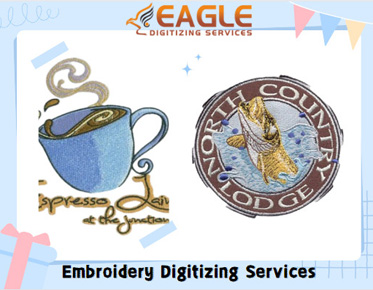How Can You Handle Low-Resolution Images in Embroidery Digitizing?
Embroidery digitizing is a meticulous craft that blends artistry with technology to transform digital images into stunning embroidered designs. However, when faced with low-resolution images, digitizers encounter unique challenges that require strategic handling and innovative solutions. In this comprehensive guide, we will explore the essential steps for effectively managing low-resolution images in embroidery digitizing, empowering embroiderers to overcome obstacles and achieve exceptional results.
Understanding Low-Resolution Images
Definition
of low-resolution images
Low-resolution images, often referred to as "low-res" images, are characterized by a limited number of pixels per inch (PPI). This results in images that appear pixelated and lack sharpness, making it challenging to capture intricate details accurately.
Common
causes of low-resolution
Low-resolution images can stem from various factors, including image compression, resizing beyond the original dimensions, and capturing images with low-quality cameras or scanners. These factors contribute to a loss of detail and clarity in the final image.
Impact
on embroidery digitizing
In the realm of embroidery digitizing, low-resolution images pose significant challenges. They may fail to accurately capture fine details, leading to a loss of clarity and fidelity in the final embroidered design. As such, digitizers need to understand the implications of working with low-resolution images and develop strategies to address them effectively.
Assessing Image Quality
Tools
for image analysis
To effectively assess the quality of low-resolution images, digitizers can utilize a range of tools for image analysis. These tools allow for the evaluation of resolution, color accuracy, and overall image clarity, providing valuable insights that inform the digitizing process.
Evaluating
resolution and clarity
When assessing image quality, digitizers must pay close attention to resolution and clarity. Low-resolution images often lack the pixel density required to accurately represent fine details, resulting in blurred edges and loss of definition.
Identifying
potential challenges
Identifying potential challenges early in the digitizing process is crucial for developing effective strategies. Common challenges associated with low-resolution images include difficulty capturing textures, loss of detail in intricate designs, and challenges in achieving smooth transitions between colors.
Preparing Low-Resolution Images
Image
enhancement techniques
To improve the quality of low-resolution images, digitizers can employ various image enhancement techniques. These may include sharpening to enhance detail, noise reduction to minimize distractions, and color correction to ensure accuracy.
Resizing
and resampling
Resizing and resampling low-resolution images can help minimize distortion and improve overall image quality. Advanced algorithms can be used to resize images while preserving essential details, ensuring that the final design retains clarity and fidelity.
Cleaning
up noise and artifacts
Cleaning up noise and artifacts is essential for enhancing the clarity of low-resolution images. Digitizers can utilize software tools to remove unwanted elements and artifacts, resulting in a cleaner and more refined image that is better suited for digitization.
Choosing Suitable Digitizing Techniques
Types
of digitizing methods
In embroidery digitization, various digitizing methods are available, each with its own strengths and limitations. When working with low-resolution images, digitizers must carefully select techniques that can effectively capture details and textures while maintaining the integrity of the design.
Considerations
for low-resolution images
When choosing digitizing techniques, digitizers must take into account the limitations of low-resolution images. Techniques such as adaptive algorithms and interpolation can help compensate for the lack of detail in low-resolution images, ensuring that important design elements are accurately captured.
Adaptive
algorithms and interpolation
Adaptive algorithms and interpolation techniques adjust stitching parameters to accommodate low-resolution images, ensuring that details are captured accurately in the final embroidered design. These techniques help maintain the integrity of the design while mitigating the effects of low resolution.
Customizing Stitch Settings
Adjusting
stitch density
Fine-tuning stitch density is crucial for achieving optimal results in embroidery digitizing. When working with low-resolution images, adjusting stitch density can help enhance details without sacrificing quality, resulting in a more refined and accurate final design.
Modifying
stitch types
Modifying stitch types allows digitizers to add texture and depth to embroidered designs. Experimenting with different stitch types can help compensate for the lack of detail in low-resolution images, resulting in designs that are visually appealing and true to the original artwork.
Enhancing
details without sacrificing quality
Finding the right balance between enhancing details and maintaining quality is essential in embroidery digitizing. Digitizers must use their expertise to ensure that enhancements do not compromise the overall integrity of the design, resulting in a final product that is both visually striking and faithful to the original image.
Manual Digitizing Techniques
Tracing
and outlining
Manual digitizing techniques involve tracing and outlining elements of the image to capture intricate details accurately. This hands-on approach allows digitizers to maintain control over the digitizing process, resulting in designs that are true to the original artwork.
Redrawing
details
Redrawing details is often necessary when working with low-resolution images. Digitizers can redraw elements to enhance clarity and ensure that essential details are captured accurately in the final design, resulting in a more polished and refined embroidered piece.
Adding
textures and gradients
Adding textures and gradients can enhance the visual appeal of embroidered designs. Digitizers can use manual techniques to add depth and dimension to low-resolution images, resulting in designs that are visually stunning and dynamic.
Utilizing Automated Software Solutions
Overview
of digitizing software
Digitizing software offers a range of tools and features for streamlining the digitizing process. When handling low-resolution images, specialized software can help automate certain tasks and improve efficiency, resulting in a more streamlined and efficient workflow.
Features
for handling low-resolution images
Some digitizing software includes features specifically designed for handling low-resolution images. These features may include image enhancement tools, adaptive algorithms, and automatic adjustments to compensate for image quality, resulting in designs that are cleaner and more refined.
Pros
and cons of automation
While automation can improve efficiency, it may not always produce the desired results when working with low-resolution images. Digitizers must weigh the pros and cons of automation and use their expertise to achieve the best possible outcome, resulting in designs that are both visually appealing and faithful to the original artwork.
Collaborating with Clients
Setting
realistic expectations
Setting realistic expectations is essential when collaborating with clients on digitizing projects. Clients should understand the limitations of low-resolution images and the challenges they may pose in achieving certain design elements, resulting in a more transparent and productive collaboration process.
Communicating
limitations and possibilities
Open communication is key to successful collaboration. Digitizers must communicate the limitations of low-resolution images to clients while exploring alternative solutions and possibilities for achieving their desired design, resulting in designs that meet or exceed client expectations.
Offering
alternative solutions
When faced with challenges in handling low-resolution images, digitizers can offer alternative solutions to clients. This may include suggesting different digitizing techniques or making adjustments to the design to accommodate the limitations of the source image, resulting in designs that are both visually appealing and technically feasible.
Testing and Iteration
Trial
stitching on sample fabric
Before finalizing the design, digitizers should conduct trial stitchings on sample fabric to assess the quality of the embroidered design. This allows them to identify any issues and make necessary adjustments before proceeding to production, resulting in designs that are more refined and polished.
Fine-tuning
settings and adjustments
Fine-tuning settings and making adjustments are essential steps in the digitizing process. Digitizers should carefully review the trial stitchings and make any necessary tweaks to improve the quality and accuracy of the design, resulting in designs that are more visually appealing and true to the original artwork.
Seeking
feedback and making revisions
Seeking feedback from clients or peers is valuable for refining the design further. Digitizers should be open to feedback and willing to make revisions to ensure that the final embroidered design meets the client's expectations, resulting in designs that are more polished and refined.
Finalizing the Design
Quality
assurance checks
Before finalizing the design, digitizers should conduct thorough quality assurance checks to ensure that all elements are in place and that the design meets the highest standards of craftsmanship, resulting in designs that are of the highest quality and accuracy.
Making
last-minute tweaks
Making any last-minute tweaks or adjustments is common in the digitizing process. Digitizers should carefully review the design and make any final adjustments to enhance clarity and detail, resulting in designs that are more visually appealing and polished.
Preparing
files for production
Once the design is finalized, digitizers should prepare the files for production. This may involve exporting the design in the appropriate file format and providing instructions for embroidery machines, resulting in designs that are ready for production and meet industry standards.
Conclusion
Handling low-resolution images in embroidery digitizing requires skill, creativity, and attention to detail. By understanding the challenges posed by low-resolution images and employing effective strategies for enhancement and digitization, digitizers can achieve stunning results that meet the expectations of clients and enthusiasts alike. With patience, experimentation, and collaboration, the possibilities for creating beautiful embroidered designs are endless.
Embark on your journey to mastery with Eagle Digitizing,
your trusted partner in embroidery digitizing services. Join us as we explore
the endless possibilities of transforming low-resolution images into works of
art that defy expectations and exceed imagination.



